Opening a Diabetes Clinic in the UK: Evaluation and Revised Proposal
VerifiedAdded on 2023/06/10
|17
|4745
|354
AI Summary
This report evaluates the proposal of opening a new diabetes clinic in the UK and provides a revised proposal to reduce expenses. It discusses the challenges in diabetes care and their solutions. The report includes an evaluation of the proposal through investment appraisal techniques and a revised proposal with increased expected revenue to achieve a rate of return of at least 8%.
Contribute Materials
Your contribution can guide someone’s learning journey. Share your
documents today.
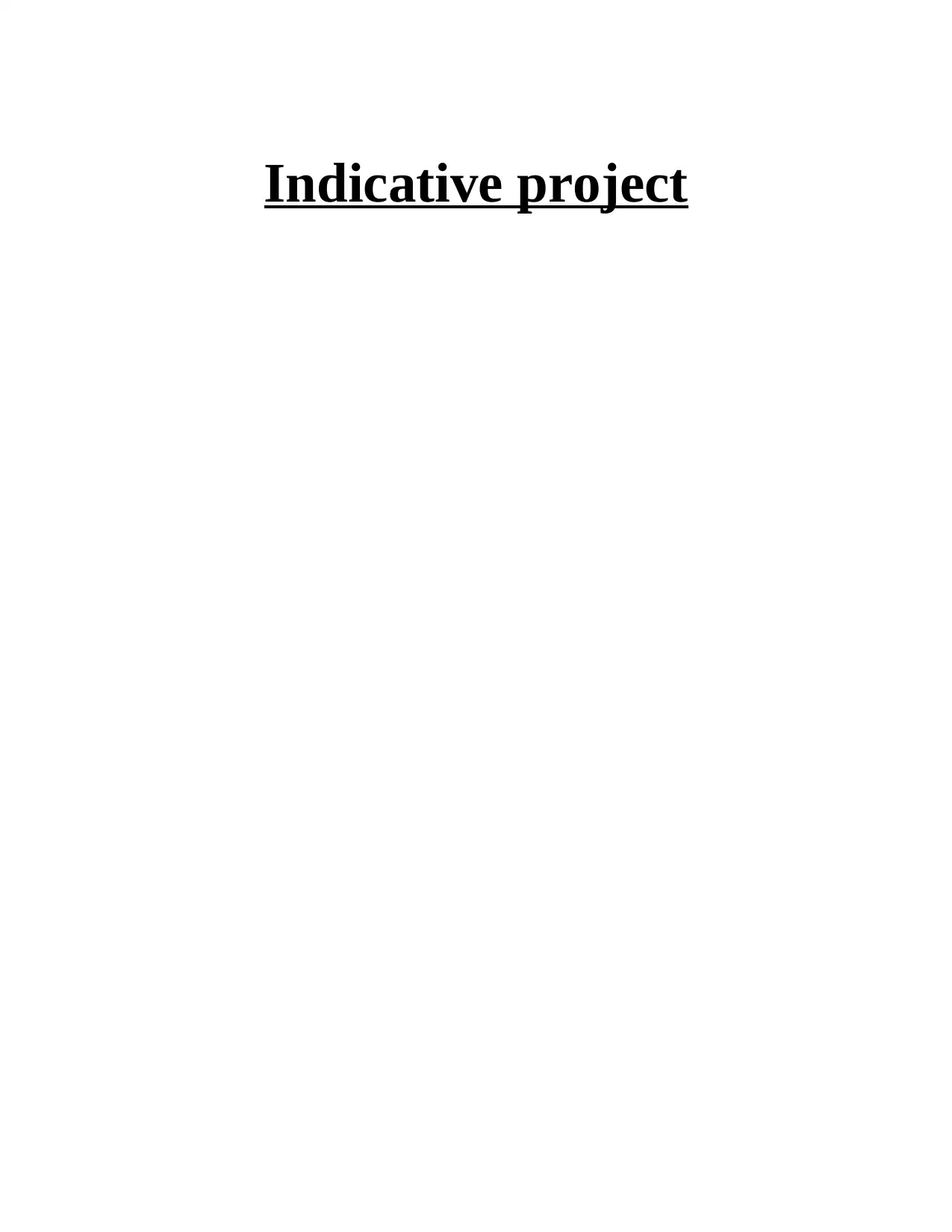
Indicative project
Secure Best Marks with AI Grader
Need help grading? Try our AI Grader for instant feedback on your assignments.
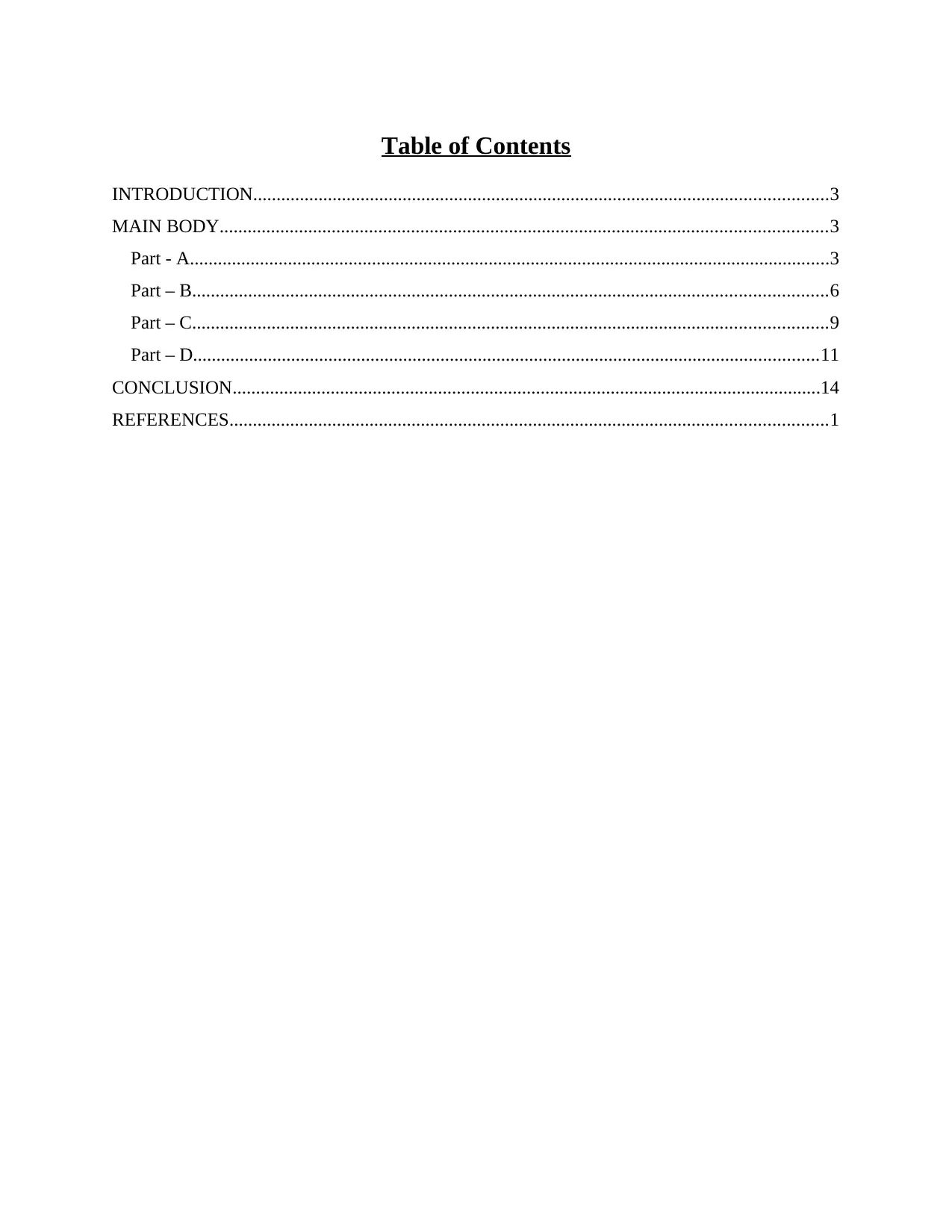
Table of Contents
INTRODUCTION...........................................................................................................................3
MAIN BODY..................................................................................................................................3
Part - A.........................................................................................................................................3
Part – B........................................................................................................................................6
Part – C........................................................................................................................................9
Part – D......................................................................................................................................11
CONCLUSION..............................................................................................................................14
REFERENCES................................................................................................................................1
INTRODUCTION...........................................................................................................................3
MAIN BODY..................................................................................................................................3
Part - A.........................................................................................................................................3
Part – B........................................................................................................................................6
Part – C........................................................................................................................................9
Part – D......................................................................................................................................11
CONCLUSION..............................................................................................................................14
REFERENCES................................................................................................................................1

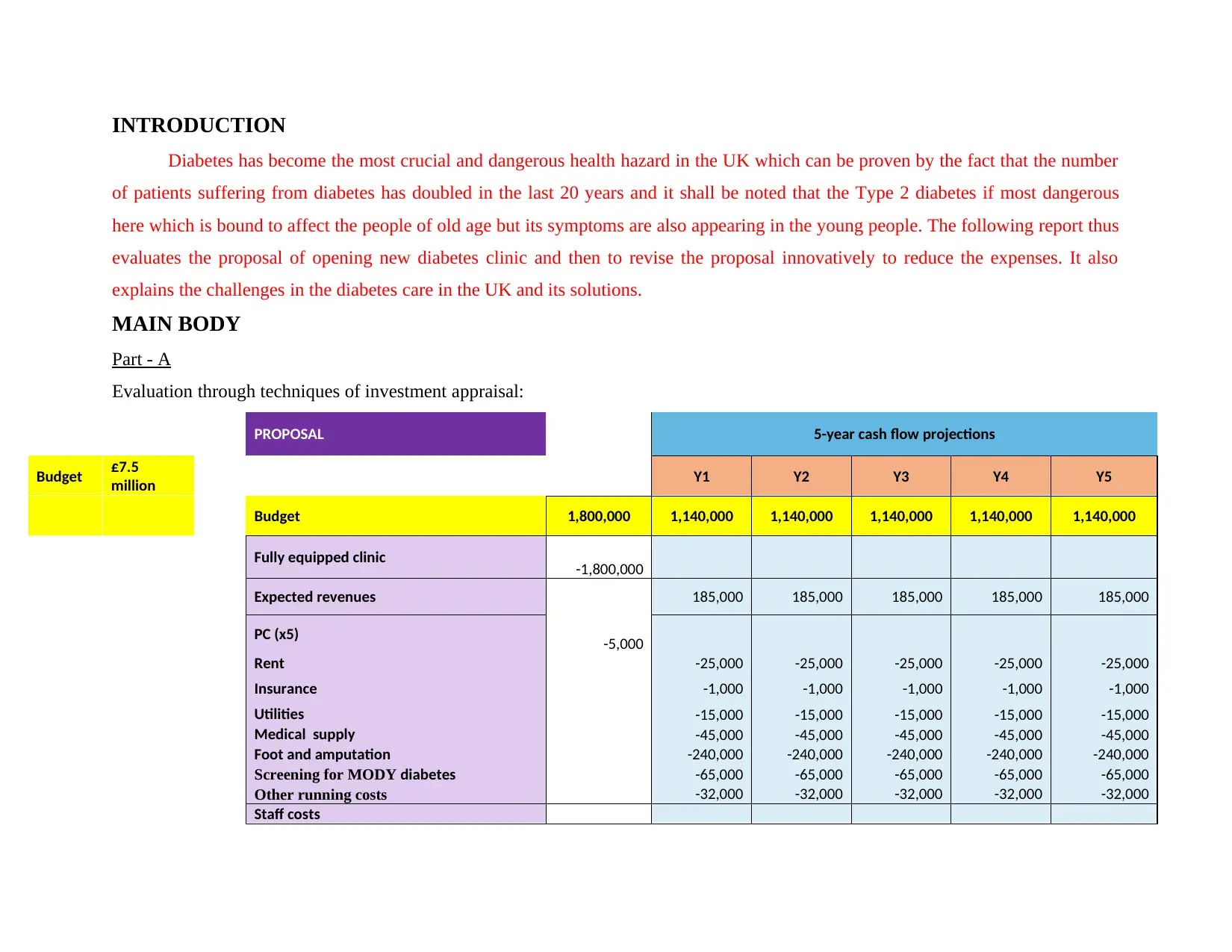
INTRODUCTION
Diabetes has become the most crucial and dangerous health hazard in the UK which can be proven by the fact that the number
of patients suffering from diabetes has doubled in the last 20 years and it shall be noted that the Type 2 diabetes if most dangerous
here which is bound to affect the people of old age but its symptoms are also appearing in the young people. The following report thus
evaluates the proposal of opening new diabetes clinic and then to revise the proposal innovatively to reduce the expenses. It also
explains the challenges in the diabetes care in the UK and its solutions.
MAIN BODY
Part - A
Evaluation through techniques of investment appraisal:
PROPOSAL 5-year cash flow projections
Budget £7.5
million Y1 Y2 Y3 Y4 Y5
Budget 1,800,000 1,140,000 1,140,000 1,140,000 1,140,000 1,140,000
Fully equipped clinic -1,800,000
Expected revenues 185,000 185,000 185,000 185,000 185,000
PC (x5) -5,000
Rent -25,000 -25,000 -25,000 -25,000 -25,000
Insurance -1,000 -1,000 -1,000 -1,000 -1,000
Utilities -15,000 -15,000 -15,000 -15,000 -15,000
Medical supply -45,000 -45,000 -45,000 -45,000 -45,000
Foot and amputation -240,000 -240,000 -240,000 -240,000 -240,000
Screening for MODY diabetes -65,000 -65,000 -65,000 -65,000 -65,000
Other running costs -32,000 -32,000 -32,000 -32,000 -32,000
Staff costs
Diabetes has become the most crucial and dangerous health hazard in the UK which can be proven by the fact that the number
of patients suffering from diabetes has doubled in the last 20 years and it shall be noted that the Type 2 diabetes if most dangerous
here which is bound to affect the people of old age but its symptoms are also appearing in the young people. The following report thus
evaluates the proposal of opening new diabetes clinic and then to revise the proposal innovatively to reduce the expenses. It also
explains the challenges in the diabetes care in the UK and its solutions.
MAIN BODY
Part - A
Evaluation through techniques of investment appraisal:
PROPOSAL 5-year cash flow projections
Budget £7.5
million Y1 Y2 Y3 Y4 Y5
Budget 1,800,000 1,140,000 1,140,000 1,140,000 1,140,000 1,140,000
Fully equipped clinic -1,800,000
Expected revenues 185,000 185,000 185,000 185,000 185,000
PC (x5) -5,000
Rent -25,000 -25,000 -25,000 -25,000 -25,000
Insurance -1,000 -1,000 -1,000 -1,000 -1,000
Utilities -15,000 -15,000 -15,000 -15,000 -15,000
Medical supply -45,000 -45,000 -45,000 -45,000 -45,000
Foot and amputation -240,000 -240,000 -240,000 -240,000 -240,000
Screening for MODY diabetes -65,000 -65,000 -65,000 -65,000 -65,000
Other running costs -32,000 -32,000 -32,000 -32,000 -32,000
Staff costs
Secure Best Marks with AI Grader
Need help grading? Try our AI Grader for instant feedback on your assignments.
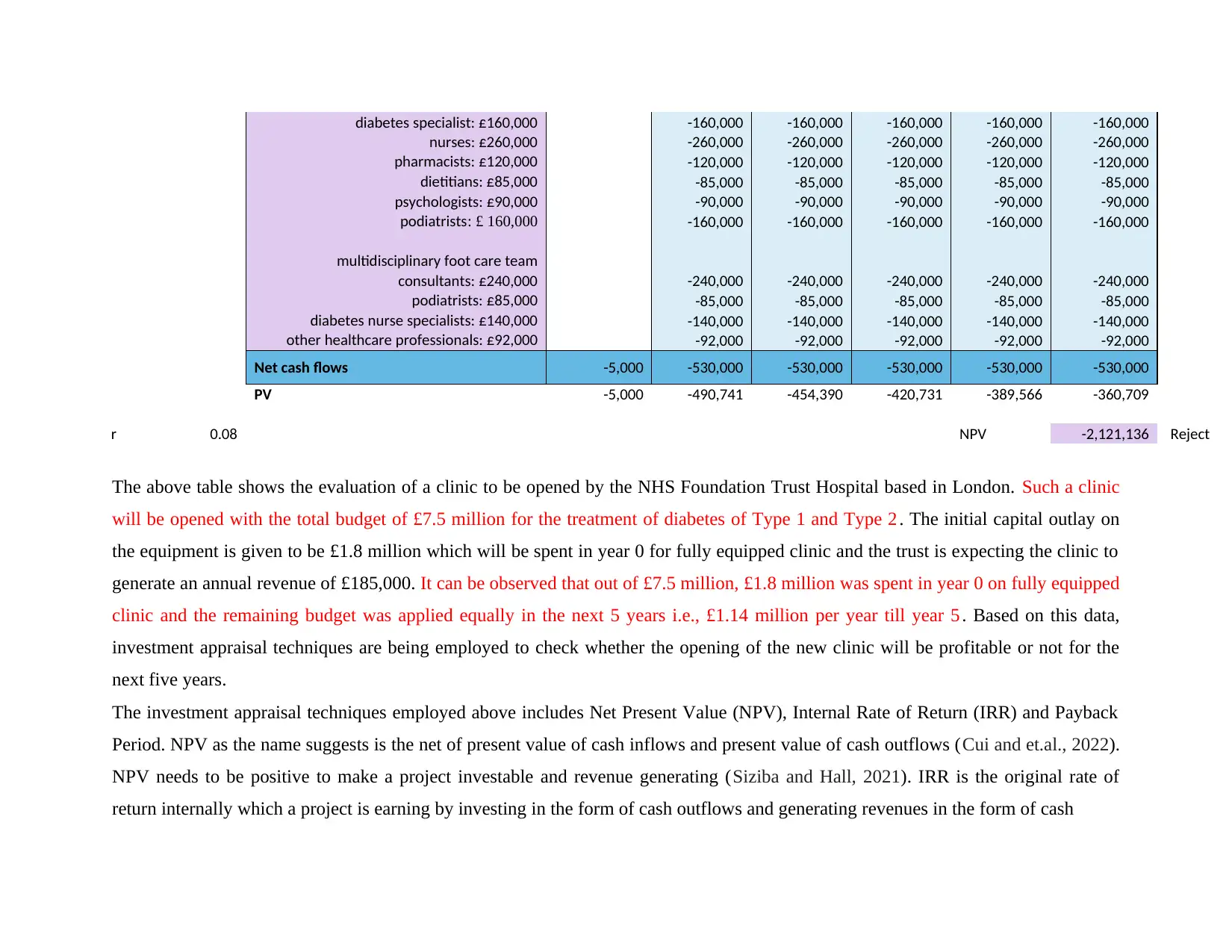
diabetes specialist: £160,000 -160,000 -160,000 -160,000 -160,000 -160,000
nurses: £260,000 -260,000 -260,000 -260,000 -260,000 -260,000
pharmacists: £120,000 -120,000 -120,000 -120,000 -120,000 -120,000
dietitians: £85,000 -85,000 -85,000 -85,000 -85,000 -85,000
psychologists: £90,000 -90,000 -90,000 -90,000 -90,000 -90,000
podiatrists: £ 160,000 -160,000 -160,000 -160,000 -160,000 -160,000
multidisciplinary foot care team
consultants: £240,000 -240,000 -240,000 -240,000 -240,000 -240,000
podiatrists: £85,000 -85,000 -85,000 -85,000 -85,000 -85,000
diabetes nurse specialists: £140,000 -140,000 -140,000 -140,000 -140,000 -140,000
other healthcare professionals: £92,000 -92,000 -92,000 -92,000 -92,000 -92,000
Net cash flows -5,000 -530,000 -530,000 -530,000 -530,000 -530,000
PV -5,000 -490,741 -454,390 -420,731 -389,566 -360,709
r 0.08 NPV -2,121,136 Reject
The above table shows the evaluation of a clinic to be opened by the NHS Foundation Trust Hospital based in London. Such a clinic
will be opened with the total budget of £7.5 million for the treatment of diabetes of Type 1 and Type 2 . The initial capital outlay on
the equipment is given to be £1.8 million which will be spent in year 0 for fully equipped clinic and the trust is expecting the clinic to
generate an annual revenue of £185,000. It can be observed that out of £7.5 million, £1.8 million was spent in year 0 on fully equipped
clinic and the remaining budget was applied equally in the next 5 years i.e., £1.14 million per year till year 5 . Based on this data,
investment appraisal techniques are being employed to check whether the opening of the new clinic will be profitable or not for the
next five years.
The investment appraisal techniques employed above includes Net Present Value (NPV), Internal Rate of Return (IRR) and Payback
Period. NPV as the name suggests is the net of present value of cash inflows and present value of cash outflows (Cui and et.al., 2022).
NPV needs to be positive to make a project investable and revenue generating (Siziba and Hall, 2021). IRR is the original rate of
return internally which a project is earning by investing in the form of cash outflows and generating revenues in the form of cash
nurses: £260,000 -260,000 -260,000 -260,000 -260,000 -260,000
pharmacists: £120,000 -120,000 -120,000 -120,000 -120,000 -120,000
dietitians: £85,000 -85,000 -85,000 -85,000 -85,000 -85,000
psychologists: £90,000 -90,000 -90,000 -90,000 -90,000 -90,000
podiatrists: £ 160,000 -160,000 -160,000 -160,000 -160,000 -160,000
multidisciplinary foot care team
consultants: £240,000 -240,000 -240,000 -240,000 -240,000 -240,000
podiatrists: £85,000 -85,000 -85,000 -85,000 -85,000 -85,000
diabetes nurse specialists: £140,000 -140,000 -140,000 -140,000 -140,000 -140,000
other healthcare professionals: £92,000 -92,000 -92,000 -92,000 -92,000 -92,000
Net cash flows -5,000 -530,000 -530,000 -530,000 -530,000 -530,000
PV -5,000 -490,741 -454,390 -420,731 -389,566 -360,709
r 0.08 NPV -2,121,136 Reject
The above table shows the evaluation of a clinic to be opened by the NHS Foundation Trust Hospital based in London. Such a clinic
will be opened with the total budget of £7.5 million for the treatment of diabetes of Type 1 and Type 2 . The initial capital outlay on
the equipment is given to be £1.8 million which will be spent in year 0 for fully equipped clinic and the trust is expecting the clinic to
generate an annual revenue of £185,000. It can be observed that out of £7.5 million, £1.8 million was spent in year 0 on fully equipped
clinic and the remaining budget was applied equally in the next 5 years i.e., £1.14 million per year till year 5 . Based on this data,
investment appraisal techniques are being employed to check whether the opening of the new clinic will be profitable or not for the
next five years.
The investment appraisal techniques employed above includes Net Present Value (NPV), Internal Rate of Return (IRR) and Payback
Period. NPV as the name suggests is the net of present value of cash inflows and present value of cash outflows (Cui and et.al., 2022).
NPV needs to be positive to make a project investable and revenue generating (Siziba and Hall, 2021). IRR is the original rate of
return internally which a project is earning by investing in the form of cash outflows and generating revenues in the form of cash
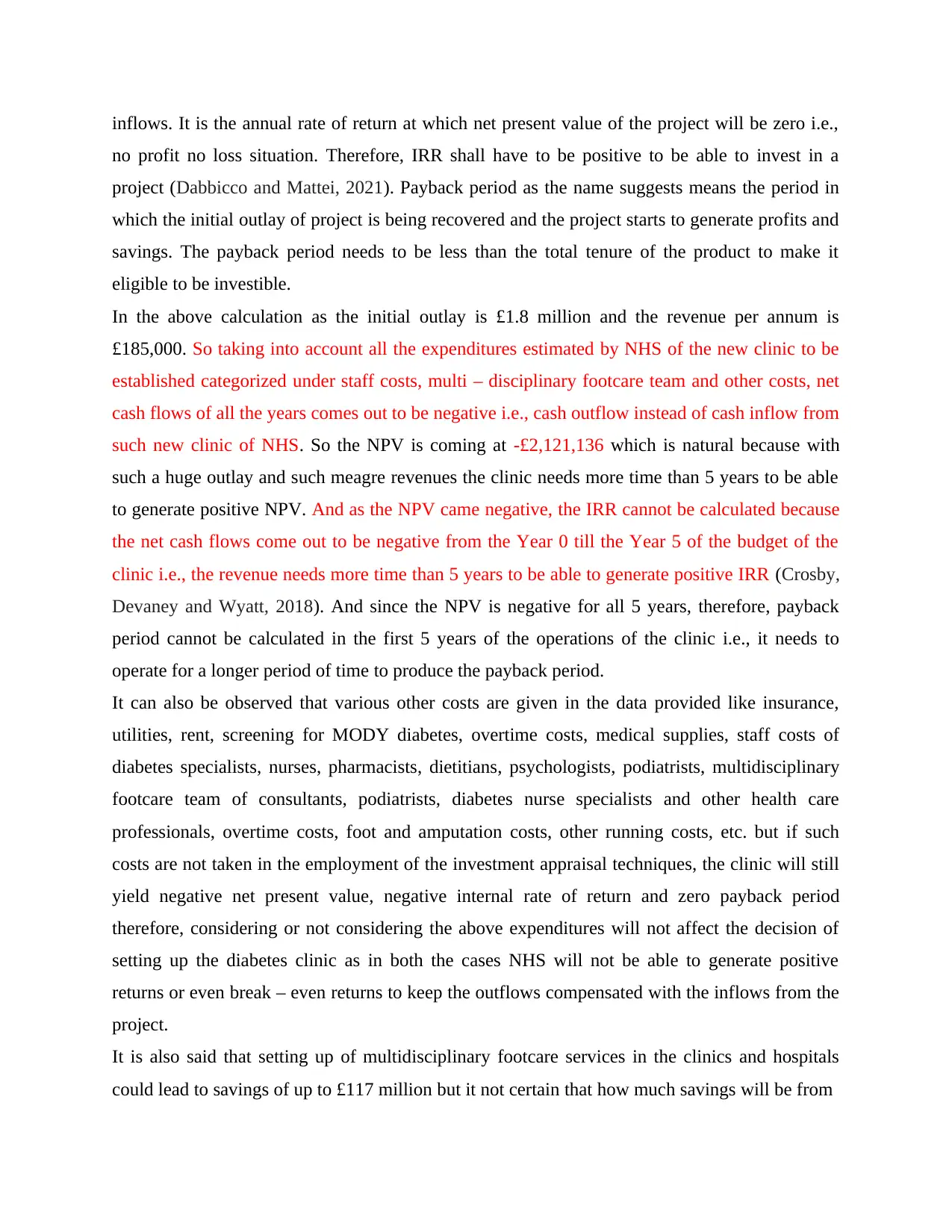
inflows. It is the annual rate of return at which net present value of the project will be zero i.e.,
no profit no loss situation. Therefore, IRR shall have to be positive to be able to invest in a
project (Dabbicco and Mattei, 2021). Payback period as the name suggests means the period in
which the initial outlay of project is being recovered and the project starts to generate profits and
savings. The payback period needs to be less than the total tenure of the product to make it
eligible to be investible.
In the above calculation as the initial outlay is £1.8 million and the revenue per annum is
£185,000. So taking into account all the expenditures estimated by NHS of the new clinic to be
established categorized under staff costs, multi – disciplinary footcare team and other costs, net
cash flows of all the years comes out to be negative i.e., cash outflow instead of cash inflow from
such new clinic of NHS. So the NPV is coming at -£2,121,136 which is natural because with
such a huge outlay and such meagre revenues the clinic needs more time than 5 years to be able
to generate positive NPV. And as the NPV came negative, the IRR cannot be calculated because
the net cash flows come out to be negative from the Year 0 till the Year 5 of the budget of the
clinic i.e., the revenue needs more time than 5 years to be able to generate positive IRR (Crosby,
Devaney and Wyatt, 2018). And since the NPV is negative for all 5 years, therefore, payback
period cannot be calculated in the first 5 years of the operations of the clinic i.e., it needs to
operate for a longer period of time to produce the payback period.
It can also be observed that various other costs are given in the data provided like insurance,
utilities, rent, screening for MODY diabetes, overtime costs, medical supplies, staff costs of
diabetes specialists, nurses, pharmacists, dietitians, psychologists, podiatrists, multidisciplinary
footcare team of consultants, podiatrists, diabetes nurse specialists and other health care
professionals, overtime costs, foot and amputation costs, other running costs, etc. but if such
costs are not taken in the employment of the investment appraisal techniques, the clinic will still
yield negative net present value, negative internal rate of return and zero payback period
therefore, considering or not considering the above expenditures will not affect the decision of
setting up the diabetes clinic as in both the cases NHS will not be able to generate positive
returns or even break – even returns to keep the outflows compensated with the inflows from the
project.
It is also said that setting up of multidisciplinary footcare services in the clinics and hospitals
could lead to savings of up to £117 million but it not certain that how much savings will be from
no profit no loss situation. Therefore, IRR shall have to be positive to be able to invest in a
project (Dabbicco and Mattei, 2021). Payback period as the name suggests means the period in
which the initial outlay of project is being recovered and the project starts to generate profits and
savings. The payback period needs to be less than the total tenure of the product to make it
eligible to be investible.
In the above calculation as the initial outlay is £1.8 million and the revenue per annum is
£185,000. So taking into account all the expenditures estimated by NHS of the new clinic to be
established categorized under staff costs, multi – disciplinary footcare team and other costs, net
cash flows of all the years comes out to be negative i.e., cash outflow instead of cash inflow from
such new clinic of NHS. So the NPV is coming at -£2,121,136 which is natural because with
such a huge outlay and such meagre revenues the clinic needs more time than 5 years to be able
to generate positive NPV. And as the NPV came negative, the IRR cannot be calculated because
the net cash flows come out to be negative from the Year 0 till the Year 5 of the budget of the
clinic i.e., the revenue needs more time than 5 years to be able to generate positive IRR (Crosby,
Devaney and Wyatt, 2018). And since the NPV is negative for all 5 years, therefore, payback
period cannot be calculated in the first 5 years of the operations of the clinic i.e., it needs to
operate for a longer period of time to produce the payback period.
It can also be observed that various other costs are given in the data provided like insurance,
utilities, rent, screening for MODY diabetes, overtime costs, medical supplies, staff costs of
diabetes specialists, nurses, pharmacists, dietitians, psychologists, podiatrists, multidisciplinary
footcare team of consultants, podiatrists, diabetes nurse specialists and other health care
professionals, overtime costs, foot and amputation costs, other running costs, etc. but if such
costs are not taken in the employment of the investment appraisal techniques, the clinic will still
yield negative net present value, negative internal rate of return and zero payback period
therefore, considering or not considering the above expenditures will not affect the decision of
setting up the diabetes clinic as in both the cases NHS will not be able to generate positive
returns or even break – even returns to keep the outflows compensated with the inflows from the
project.
It is also said that setting up of multidisciplinary footcare services in the clinics and hospitals
could lead to savings of up to £117 million but it not certain that how much savings will be from
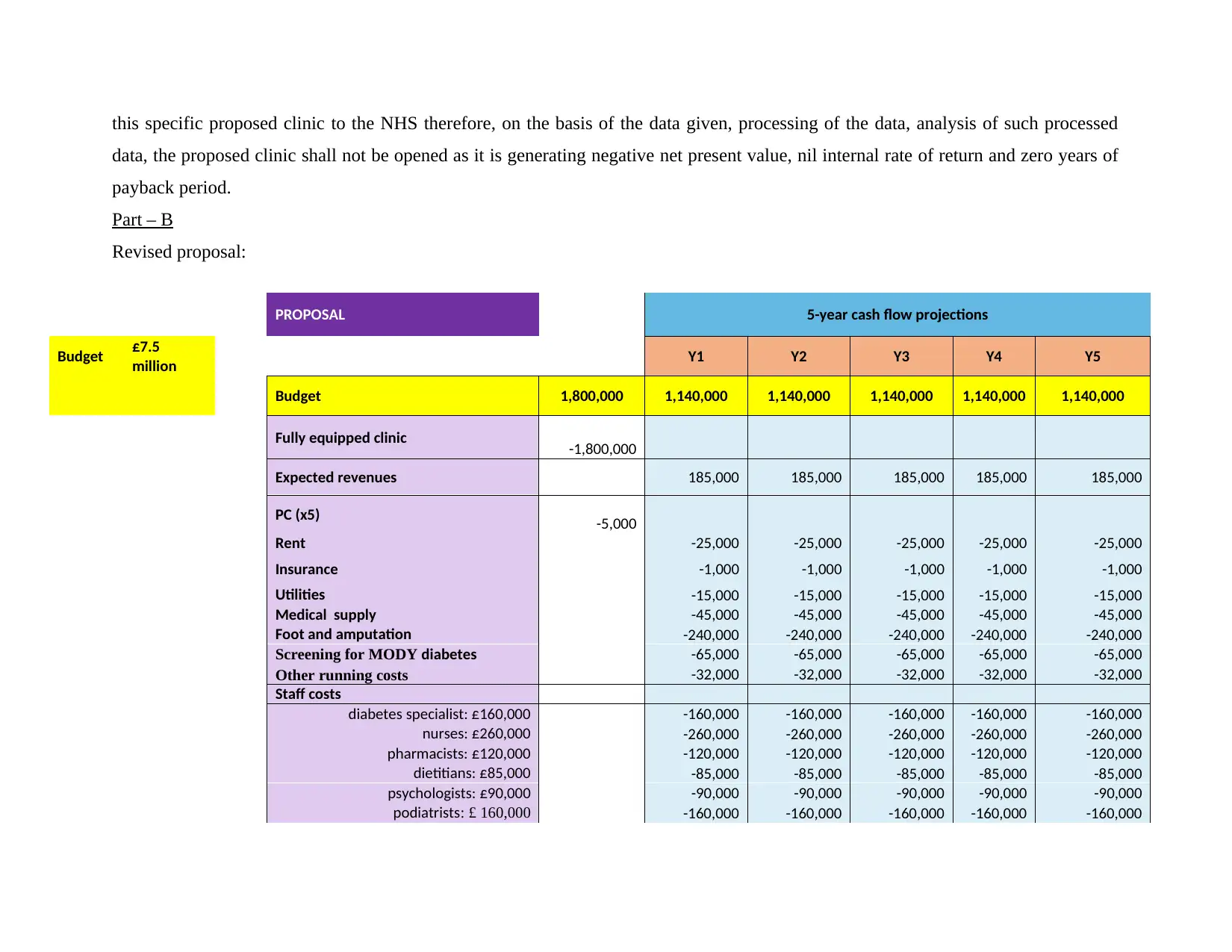
this specific proposed clinic to the NHS therefore, on the basis of the data given, processing of the data, analysis of such processed
data, the proposed clinic shall not be opened as it is generating negative net present value, nil internal rate of return and zero years of
payback period.
Part – B
Revised proposal:
PROPOSAL 5-year cash flow projections
Budget £7.5
million Y1 Y2 Y3 Y4 Y5
Budget 1,800,000 1,140,000 1,140,000 1,140,000 1,140,000 1,140,000
Fully equipped clinic -1,800,000
Expected revenues 185,000 185,000 185,000 185,000 185,000
PC (x5) -5,000
Rent -25,000 -25,000 -25,000 -25,000 -25,000
Insurance -1,000 -1,000 -1,000 -1,000 -1,000
Utilities -15,000 -15,000 -15,000 -15,000 -15,000
Medical supply -45,000 -45,000 -45,000 -45,000 -45,000
Foot and amputation -240,000 -240,000 -240,000 -240,000 -240,000
Screening for MODY diabetes -65,000 -65,000 -65,000 -65,000 -65,000
Other running costs -32,000 -32,000 -32,000 -32,000 -32,000
Staff costs
diabetes specialist: £160,000 -160,000 -160,000 -160,000 -160,000 -160,000
nurses: £260,000 -260,000 -260,000 -260,000 -260,000 -260,000
pharmacists: £120,000 -120,000 -120,000 -120,000 -120,000 -120,000
dietitians: £85,000 -85,000 -85,000 -85,000 -85,000 -85,000
psychologists: £90,000 -90,000 -90,000 -90,000 -90,000 -90,000
podiatrists: £ 160,000 -160,000 -160,000 -160,000 -160,000 -160,000
data, the proposed clinic shall not be opened as it is generating negative net present value, nil internal rate of return and zero years of
payback period.
Part – B
Revised proposal:
PROPOSAL 5-year cash flow projections
Budget £7.5
million Y1 Y2 Y3 Y4 Y5
Budget 1,800,000 1,140,000 1,140,000 1,140,000 1,140,000 1,140,000
Fully equipped clinic -1,800,000
Expected revenues 185,000 185,000 185,000 185,000 185,000
PC (x5) -5,000
Rent -25,000 -25,000 -25,000 -25,000 -25,000
Insurance -1,000 -1,000 -1,000 -1,000 -1,000
Utilities -15,000 -15,000 -15,000 -15,000 -15,000
Medical supply -45,000 -45,000 -45,000 -45,000 -45,000
Foot and amputation -240,000 -240,000 -240,000 -240,000 -240,000
Screening for MODY diabetes -65,000 -65,000 -65,000 -65,000 -65,000
Other running costs -32,000 -32,000 -32,000 -32,000 -32,000
Staff costs
diabetes specialist: £160,000 -160,000 -160,000 -160,000 -160,000 -160,000
nurses: £260,000 -260,000 -260,000 -260,000 -260,000 -260,000
pharmacists: £120,000 -120,000 -120,000 -120,000 -120,000 -120,000
dietitians: £85,000 -85,000 -85,000 -85,000 -85,000 -85,000
psychologists: £90,000 -90,000 -90,000 -90,000 -90,000 -90,000
podiatrists: £ 160,000 -160,000 -160,000 -160,000 -160,000 -160,000
Paraphrase This Document
Need a fresh take? Get an instant paraphrase of this document with our AI Paraphraser
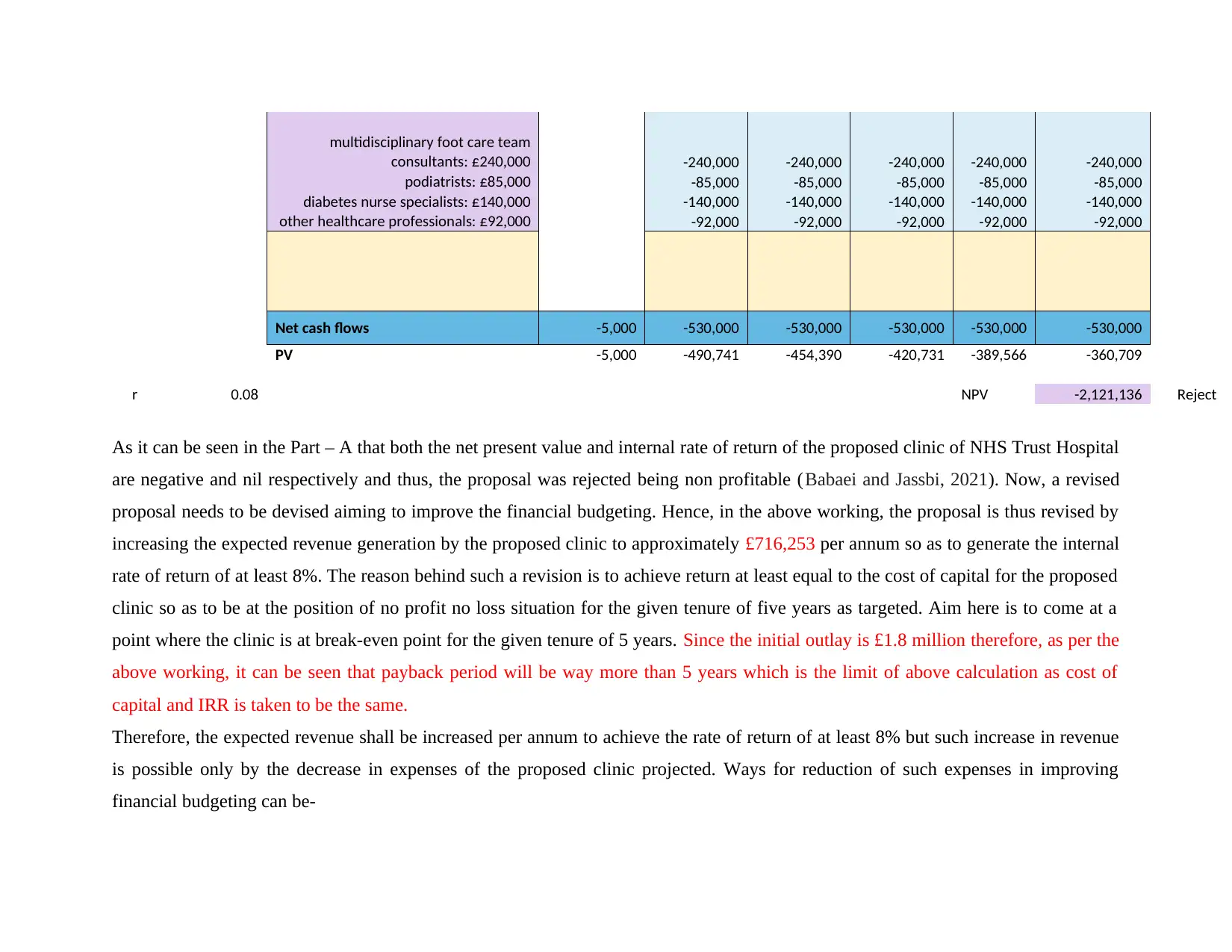
multidisciplinary foot care team
consultants: £240,000 -240,000 -240,000 -240,000 -240,000 -240,000
podiatrists: £85,000 -85,000 -85,000 -85,000 -85,000 -85,000
diabetes nurse specialists: £140,000 -140,000 -140,000 -140,000 -140,000 -140,000
other healthcare professionals: £92,000 -92,000 -92,000 -92,000 -92,000 -92,000
Net cash flows -5,000 -530,000 -530,000 -530,000 -530,000 -530,000
PV -5,000 -490,741 -454,390 -420,731 -389,566 -360,709
r 0.08 NPV -2,121,136 Reject
As it can be seen in the Part – A that both the net present value and internal rate of return of the proposed clinic of NHS Trust Hospital
are negative and nil respectively and thus, the proposal was rejected being non profitable (Babaei and Jassbi, 2021). Now, a revised
proposal needs to be devised aiming to improve the financial budgeting. Hence, in the above working, the proposal is thus revised by
increasing the expected revenue generation by the proposed clinic to approximately £716,253 per annum so as to generate the internal
rate of return of at least 8%. The reason behind such a revision is to achieve return at least equal to the cost of capital for the proposed
clinic so as to be at the position of no profit no loss situation for the given tenure of five years as targeted. Aim here is to come at a
point where the clinic is at break-even point for the given tenure of 5 years. Since the initial outlay is £1.8 million therefore, as per the
above working, it can be seen that payback period will be way more than 5 years which is the limit of above calculation as cost of
capital and IRR is taken to be the same.
Therefore, the expected revenue shall be increased per annum to achieve the rate of return of at least 8% but such increase in revenue
is possible only by the decrease in expenses of the proposed clinic projected. Ways for reduction of such expenses in improving
financial budgeting can be-
consultants: £240,000 -240,000 -240,000 -240,000 -240,000 -240,000
podiatrists: £85,000 -85,000 -85,000 -85,000 -85,000 -85,000
diabetes nurse specialists: £140,000 -140,000 -140,000 -140,000 -140,000 -140,000
other healthcare professionals: £92,000 -92,000 -92,000 -92,000 -92,000 -92,000
Net cash flows -5,000 -530,000 -530,000 -530,000 -530,000 -530,000
PV -5,000 -490,741 -454,390 -420,731 -389,566 -360,709
r 0.08 NPV -2,121,136 Reject
As it can be seen in the Part – A that both the net present value and internal rate of return of the proposed clinic of NHS Trust Hospital
are negative and nil respectively and thus, the proposal was rejected being non profitable (Babaei and Jassbi, 2021). Now, a revised
proposal needs to be devised aiming to improve the financial budgeting. Hence, in the above working, the proposal is thus revised by
increasing the expected revenue generation by the proposed clinic to approximately £716,253 per annum so as to generate the internal
rate of return of at least 8%. The reason behind such a revision is to achieve return at least equal to the cost of capital for the proposed
clinic so as to be at the position of no profit no loss situation for the given tenure of five years as targeted. Aim here is to come at a
point where the clinic is at break-even point for the given tenure of 5 years. Since the initial outlay is £1.8 million therefore, as per the
above working, it can be seen that payback period will be way more than 5 years which is the limit of above calculation as cost of
capital and IRR is taken to be the same.
Therefore, the expected revenue shall be increased per annum to achieve the rate of return of at least 8% but such increase in revenue
is possible only by the decrease in expenses of the proposed clinic projected. Ways for reduction of such expenses in improving
financial budgeting can be-
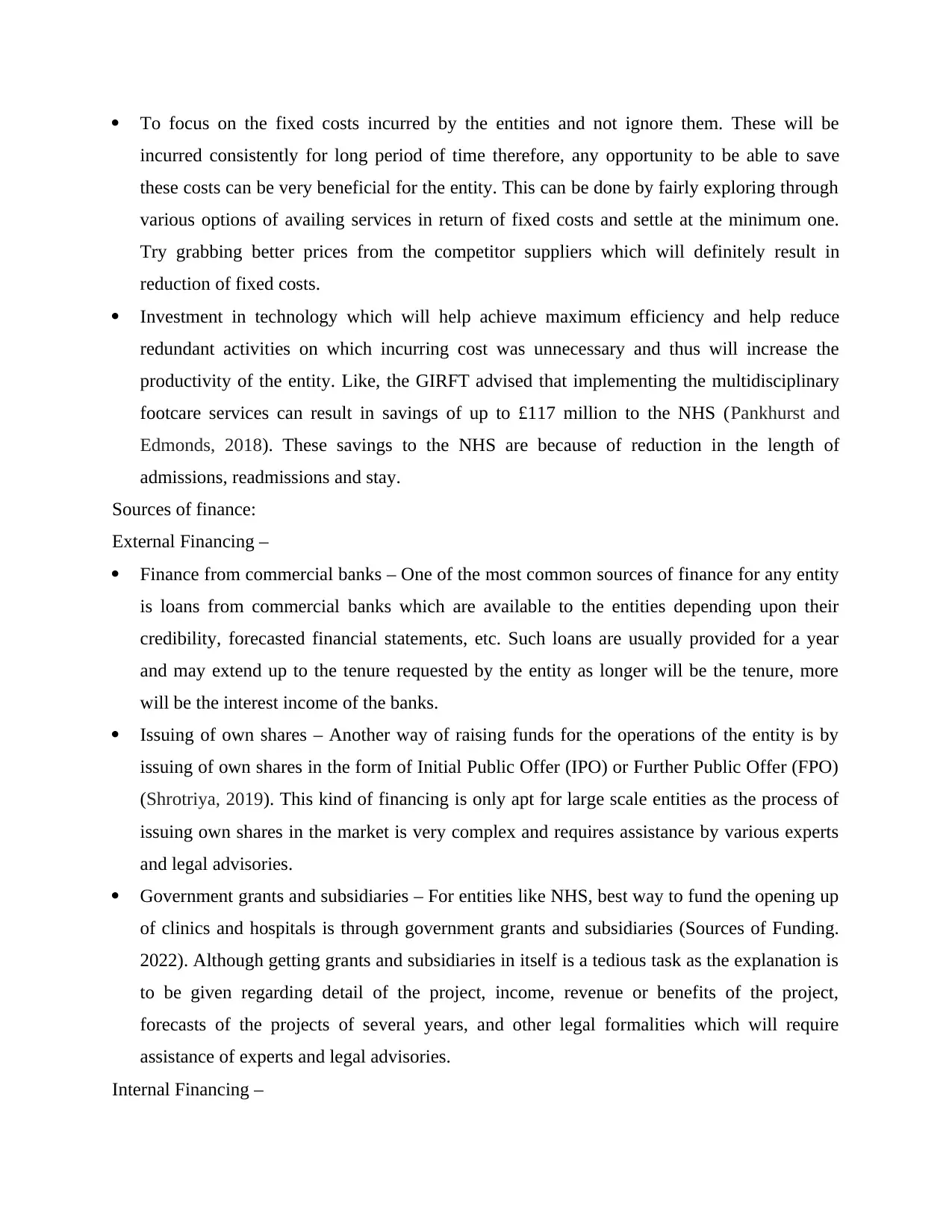
To focus on the fixed costs incurred by the entities and not ignore them. These will be
incurred consistently for long period of time therefore, any opportunity to be able to save
these costs can be very beneficial for the entity. This can be done by fairly exploring through
various options of availing services in return of fixed costs and settle at the minimum one.
Try grabbing better prices from the competitor suppliers which will definitely result in
reduction of fixed costs.
Investment in technology which will help achieve maximum efficiency and help reduce
redundant activities on which incurring cost was unnecessary and thus will increase the
productivity of the entity. Like, the GIRFT advised that implementing the multidisciplinary
footcare services can result in savings of up to £117 million to the NHS (Pankhurst and
Edmonds, 2018). These savings to the NHS are because of reduction in the length of
admissions, readmissions and stay.
Sources of finance:
External Financing –
Finance from commercial banks – One of the most common sources of finance for any entity
is loans from commercial banks which are available to the entities depending upon their
credibility, forecasted financial statements, etc. Such loans are usually provided for a year
and may extend up to the tenure requested by the entity as longer will be the tenure, more
will be the interest income of the banks.
Issuing of own shares – Another way of raising funds for the operations of the entity is by
issuing of own shares in the form of Initial Public Offer (IPO) or Further Public Offer (FPO)
(Shrotriya, 2019). This kind of financing is only apt for large scale entities as the process of
issuing own shares in the market is very complex and requires assistance by various experts
and legal advisories.
Government grants and subsidiaries – For entities like NHS, best way to fund the opening up
of clinics and hospitals is through government grants and subsidiaries (Sources of Funding.
2022). Although getting grants and subsidiaries in itself is a tedious task as the explanation is
to be given regarding detail of the project, income, revenue or benefits of the project,
forecasts of the projects of several years, and other legal formalities which will require
assistance of experts and legal advisories.
Internal Financing –
incurred consistently for long period of time therefore, any opportunity to be able to save
these costs can be very beneficial for the entity. This can be done by fairly exploring through
various options of availing services in return of fixed costs and settle at the minimum one.
Try grabbing better prices from the competitor suppliers which will definitely result in
reduction of fixed costs.
Investment in technology which will help achieve maximum efficiency and help reduce
redundant activities on which incurring cost was unnecessary and thus will increase the
productivity of the entity. Like, the GIRFT advised that implementing the multidisciplinary
footcare services can result in savings of up to £117 million to the NHS (Pankhurst and
Edmonds, 2018). These savings to the NHS are because of reduction in the length of
admissions, readmissions and stay.
Sources of finance:
External Financing –
Finance from commercial banks – One of the most common sources of finance for any entity
is loans from commercial banks which are available to the entities depending upon their
credibility, forecasted financial statements, etc. Such loans are usually provided for a year
and may extend up to the tenure requested by the entity as longer will be the tenure, more
will be the interest income of the banks.
Issuing of own shares – Another way of raising funds for the operations of the entity is by
issuing of own shares in the form of Initial Public Offer (IPO) or Further Public Offer (FPO)
(Shrotriya, 2019). This kind of financing is only apt for large scale entities as the process of
issuing own shares in the market is very complex and requires assistance by various experts
and legal advisories.
Government grants and subsidiaries – For entities like NHS, best way to fund the opening up
of clinics and hospitals is through government grants and subsidiaries (Sources of Funding.
2022). Although getting grants and subsidiaries in itself is a tedious task as the explanation is
to be given regarding detail of the project, income, revenue or benefits of the project,
forecasts of the projects of several years, and other legal formalities which will require
assistance of experts and legal advisories.
Internal Financing –
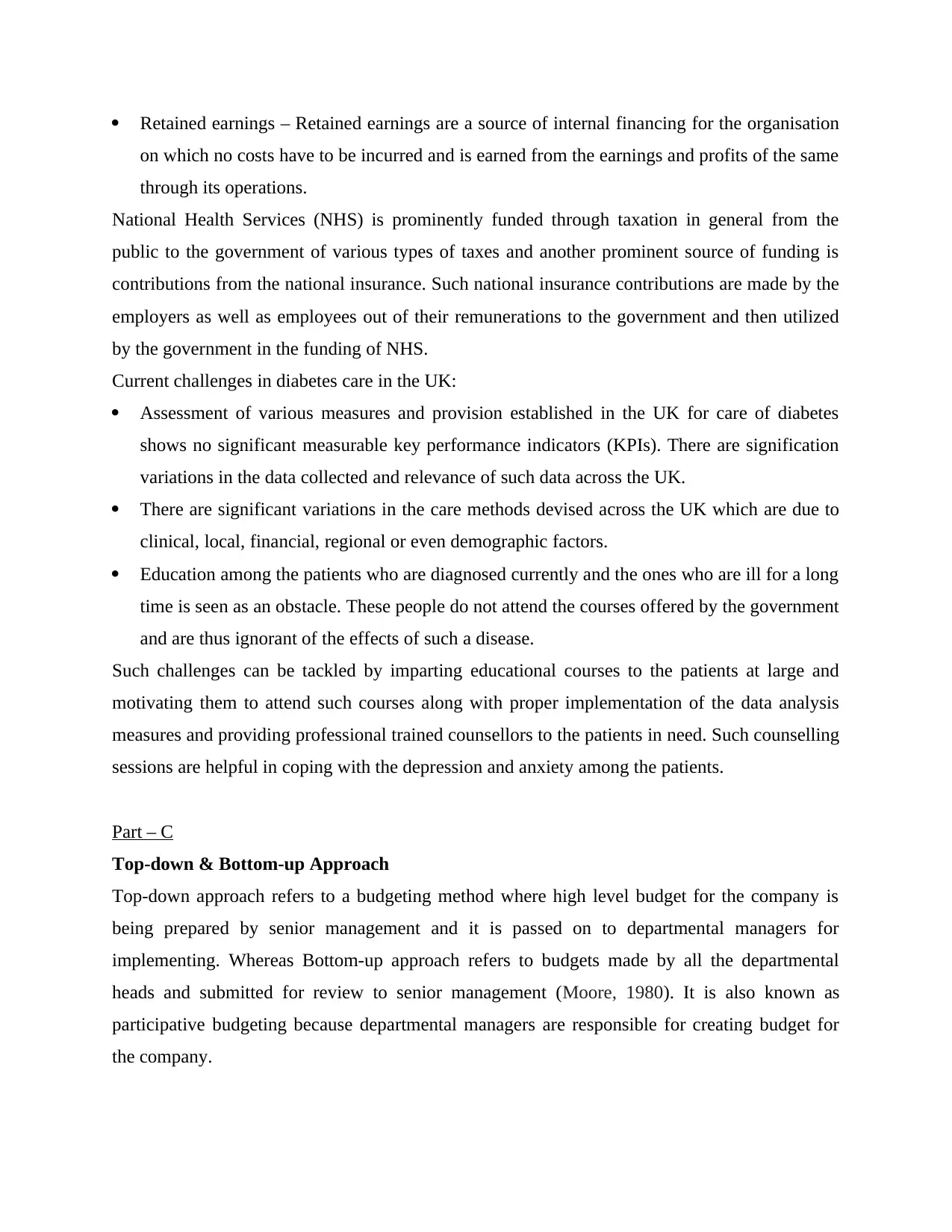
Retained earnings – Retained earnings are a source of internal financing for the organisation
on which no costs have to be incurred and is earned from the earnings and profits of the same
through its operations.
National Health Services (NHS) is prominently funded through taxation in general from the
public to the government of various types of taxes and another prominent source of funding is
contributions from the national insurance. Such national insurance contributions are made by the
employers as well as employees out of their remunerations to the government and then utilized
by the government in the funding of NHS.
Current challenges in diabetes care in the UK:
Assessment of various measures and provision established in the UK for care of diabetes
shows no significant measurable key performance indicators (KPIs). There are signification
variations in the data collected and relevance of such data across the UK.
There are significant variations in the care methods devised across the UK which are due to
clinical, local, financial, regional or even demographic factors.
Education among the patients who are diagnosed currently and the ones who are ill for a long
time is seen as an obstacle. These people do not attend the courses offered by the government
and are thus ignorant of the effects of such a disease.
Such challenges can be tackled by imparting educational courses to the patients at large and
motivating them to attend such courses along with proper implementation of the data analysis
measures and providing professional trained counsellors to the patients in need. Such counselling
sessions are helpful in coping with the depression and anxiety among the patients.
Part – C
Top-down & Bottom-up Approach
Top-down approach refers to a budgeting method where high level budget for the company is
being prepared by senior management and it is passed on to departmental managers for
implementing. Whereas Bottom-up approach refers to budgets made by all the departmental
heads and submitted for review to senior management (Moore, 1980). It is also known as
participative budgeting because departmental managers are responsible for creating budget for
the company.
on which no costs have to be incurred and is earned from the earnings and profits of the same
through its operations.
National Health Services (NHS) is prominently funded through taxation in general from the
public to the government of various types of taxes and another prominent source of funding is
contributions from the national insurance. Such national insurance contributions are made by the
employers as well as employees out of their remunerations to the government and then utilized
by the government in the funding of NHS.
Current challenges in diabetes care in the UK:
Assessment of various measures and provision established in the UK for care of diabetes
shows no significant measurable key performance indicators (KPIs). There are signification
variations in the data collected and relevance of such data across the UK.
There are significant variations in the care methods devised across the UK which are due to
clinical, local, financial, regional or even demographic factors.
Education among the patients who are diagnosed currently and the ones who are ill for a long
time is seen as an obstacle. These people do not attend the courses offered by the government
and are thus ignorant of the effects of such a disease.
Such challenges can be tackled by imparting educational courses to the patients at large and
motivating them to attend such courses along with proper implementation of the data analysis
measures and providing professional trained counsellors to the patients in need. Such counselling
sessions are helpful in coping with the depression and anxiety among the patients.
Part – C
Top-down & Bottom-up Approach
Top-down approach refers to a budgeting method where high level budget for the company is
being prepared by senior management and it is passed on to departmental managers for
implementing. Whereas Bottom-up approach refers to budgets made by all the departmental
heads and submitted for review to senior management (Moore, 1980). It is also known as
participative budgeting because departmental managers are responsible for creating budget for
the company.
Secure Best Marks with AI Grader
Need help grading? Try our AI Grader for instant feedback on your assignments.
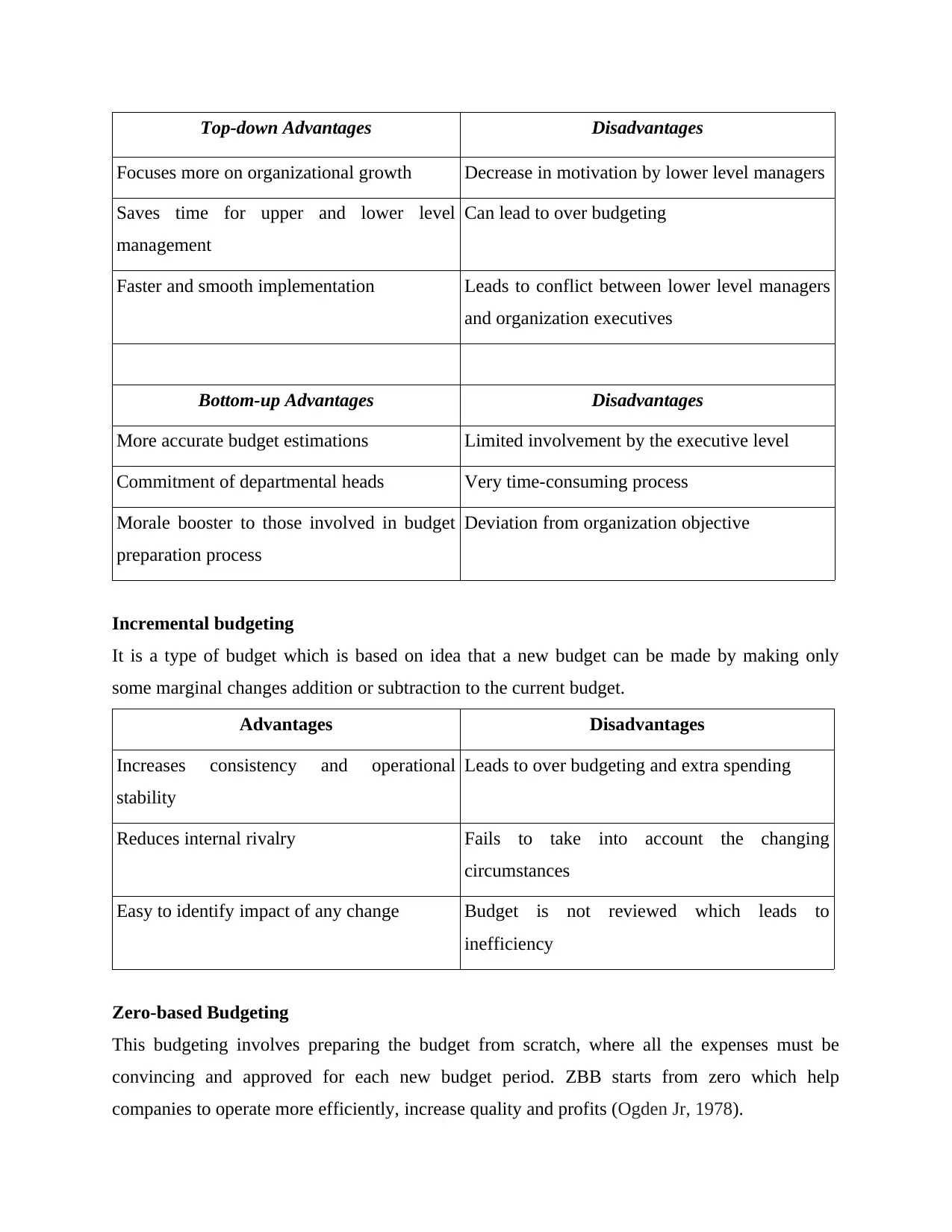
Top-down Advantages Disadvantages
Focuses more on organizational growth Decrease in motivation by lower level managers
Saves time for upper and lower level
management
Can lead to over budgeting
Faster and smooth implementation Leads to conflict between lower level managers
and organization executives
Bottom-up Advantages Disadvantages
More accurate budget estimations Limited involvement by the executive level
Commitment of departmental heads Very time-consuming process
Morale booster to those involved in budget
preparation process
Deviation from organization objective
Incremental budgeting
It is a type of budget which is based on idea that a new budget can be made by making only
some marginal changes addition or subtraction to the current budget.
Advantages Disadvantages
Increases consistency and operational
stability
Leads to over budgeting and extra spending
Reduces internal rivalry Fails to take into account the changing
circumstances
Easy to identify impact of any change Budget is not reviewed which leads to
inefficiency
Zero-based Budgeting
This budgeting involves preparing the budget from scratch, where all the expenses must be
convincing and approved for each new budget period. ZBB starts from zero which help
companies to operate more efficiently, increase quality and profits (Ogden Jr, 1978).
Focuses more on organizational growth Decrease in motivation by lower level managers
Saves time for upper and lower level
management
Can lead to over budgeting
Faster and smooth implementation Leads to conflict between lower level managers
and organization executives
Bottom-up Advantages Disadvantages
More accurate budget estimations Limited involvement by the executive level
Commitment of departmental heads Very time-consuming process
Morale booster to those involved in budget
preparation process
Deviation from organization objective
Incremental budgeting
It is a type of budget which is based on idea that a new budget can be made by making only
some marginal changes addition or subtraction to the current budget.
Advantages Disadvantages
Increases consistency and operational
stability
Leads to over budgeting and extra spending
Reduces internal rivalry Fails to take into account the changing
circumstances
Easy to identify impact of any change Budget is not reviewed which leads to
inefficiency
Zero-based Budgeting
This budgeting involves preparing the budget from scratch, where all the expenses must be
convincing and approved for each new budget period. ZBB starts from zero which help
companies to operate more efficiently, increase quality and profits (Ogden Jr, 1978).
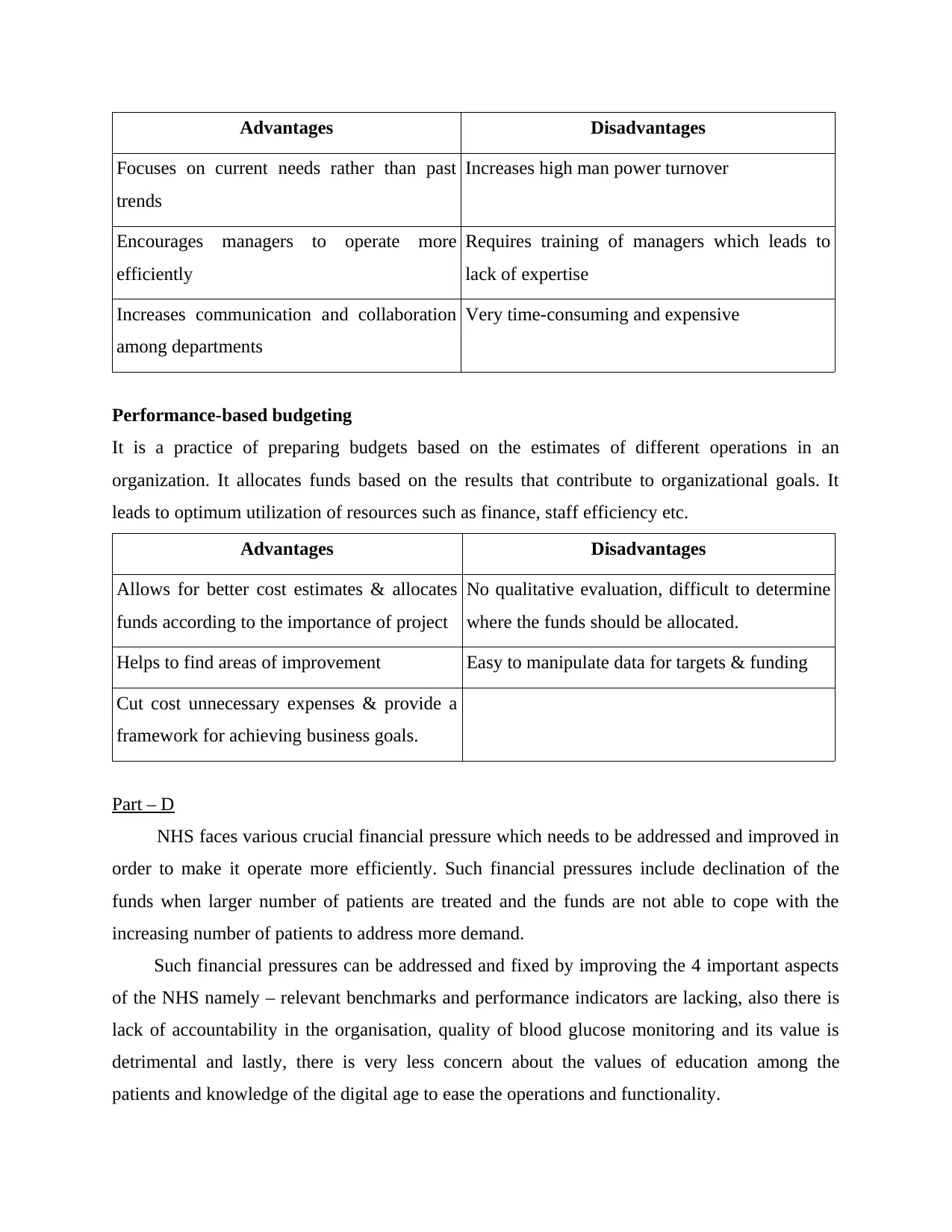
Advantages Disadvantages
Focuses on current needs rather than past
trends
Increases high man power turnover
Encourages managers to operate more
efficiently
Requires training of managers which leads to
lack of expertise
Increases communication and collaboration
among departments
Very time-consuming and expensive
Performance-based budgeting
It is a practice of preparing budgets based on the estimates of different operations in an
organization. It allocates funds based on the results that contribute to organizational goals. It
leads to optimum utilization of resources such as finance, staff efficiency etc.
Advantages Disadvantages
Allows for better cost estimates & allocates
funds according to the importance of project
No qualitative evaluation, difficult to determine
where the funds should be allocated.
Helps to find areas of improvement Easy to manipulate data for targets & funding
Cut cost unnecessary expenses & provide a
framework for achieving business goals.
Part – D
NHS faces various crucial financial pressure which needs to be addressed and improved in
order to make it operate more efficiently. Such financial pressures include declination of the
funds when larger number of patients are treated and the funds are not able to cope with the
increasing number of patients to address more demand.
Such financial pressures can be addressed and fixed by improving the 4 important aspects
of the NHS namely – relevant benchmarks and performance indicators are lacking, also there is
lack of accountability in the organisation, quality of blood glucose monitoring and its value is
detrimental and lastly, there is very less concern about the values of education among the
patients and knowledge of the digital age to ease the operations and functionality.
Focuses on current needs rather than past
trends
Increases high man power turnover
Encourages managers to operate more
efficiently
Requires training of managers which leads to
lack of expertise
Increases communication and collaboration
among departments
Very time-consuming and expensive
Performance-based budgeting
It is a practice of preparing budgets based on the estimates of different operations in an
organization. It allocates funds based on the results that contribute to organizational goals. It
leads to optimum utilization of resources such as finance, staff efficiency etc.
Advantages Disadvantages
Allows for better cost estimates & allocates
funds according to the importance of project
No qualitative evaluation, difficult to determine
where the funds should be allocated.
Helps to find areas of improvement Easy to manipulate data for targets & funding
Cut cost unnecessary expenses & provide a
framework for achieving business goals.
Part – D
NHS faces various crucial financial pressure which needs to be addressed and improved in
order to make it operate more efficiently. Such financial pressures include declination of the
funds when larger number of patients are treated and the funds are not able to cope with the
increasing number of patients to address more demand.
Such financial pressures can be addressed and fixed by improving the 4 important aspects
of the NHS namely – relevant benchmarks and performance indicators are lacking, also there is
lack of accountability in the organisation, quality of blood glucose monitoring and its value is
detrimental and lastly, there is very less concern about the values of education among the
patients and knowledge of the digital age to ease the operations and functionality.
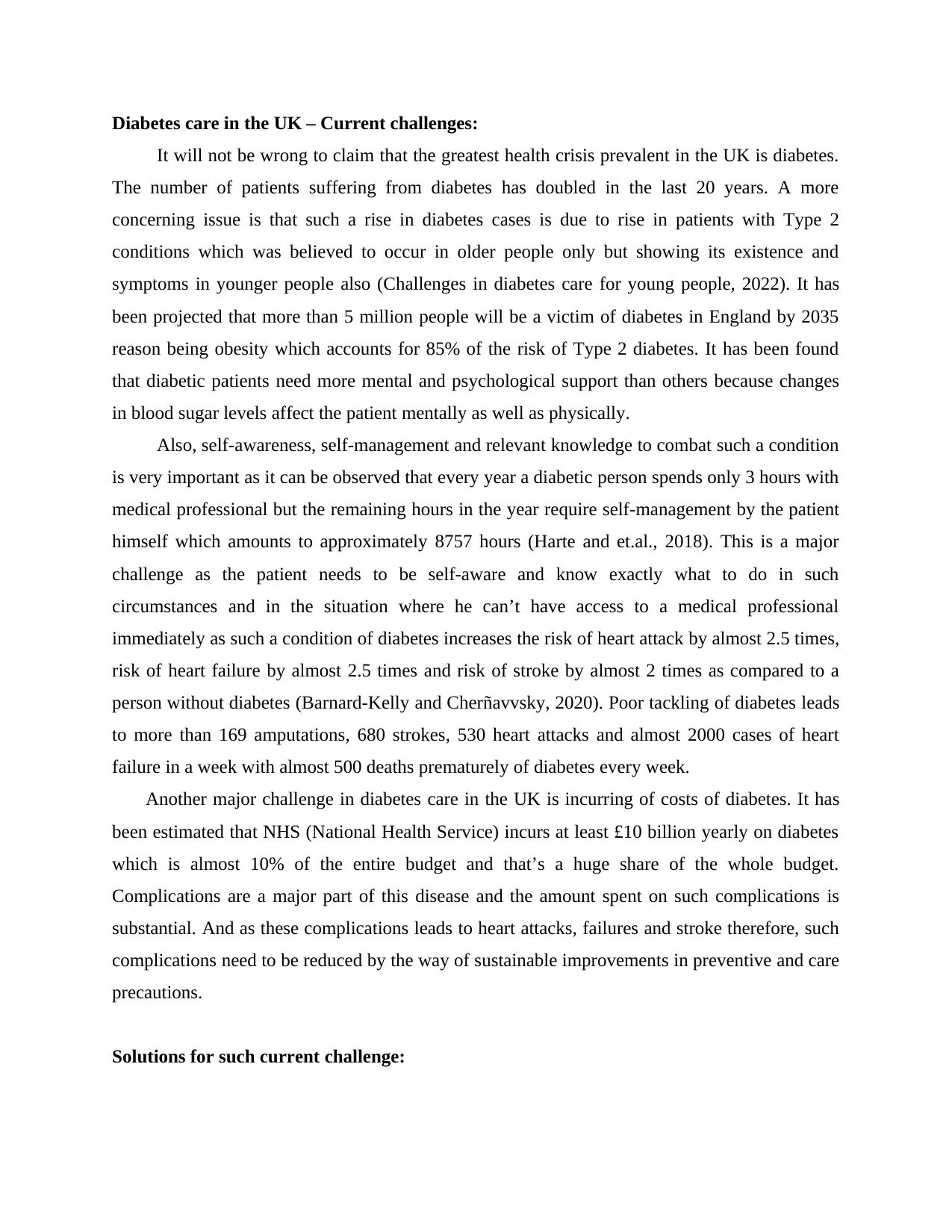
Diabetes care in the UK – Current challenges:
It will not be wrong to claim that the greatest health crisis prevalent in the UK is diabetes.
The number of patients suffering from diabetes has doubled in the last 20 years. A more
concerning issue is that such a rise in diabetes cases is due to rise in patients with Type 2
conditions which was believed to occur in older people only but showing its existence and
symptoms in younger people also (Challenges in diabetes care for young people, 2022). It has
been projected that more than 5 million people will be a victim of diabetes in England by 2035
reason being obesity which accounts for 85% of the risk of Type 2 diabetes. It has been found
that diabetic patients need more mental and psychological support than others because changes
in blood sugar levels affect the patient mentally as well as physically.
Also, self-awareness, self-management and relevant knowledge to combat such a condition
is very important as it can be observed that every year a diabetic person spends only 3 hours with
medical professional but the remaining hours in the year require self-management by the patient
himself which amounts to approximately 8757 hours (Harte and et.al., 2018). This is a major
challenge as the patient needs to be self-aware and know exactly what to do in such
circumstances and in the situation where he can’t have access to a medical professional
immediately as such a condition of diabetes increases the risk of heart attack by almost 2.5 times,
risk of heart failure by almost 2.5 times and risk of stroke by almost 2 times as compared to a
person without diabetes (Barnard-Kelly and Cherñavvsky, 2020). Poor tackling of diabetes leads
to more than 169 amputations, 680 strokes, 530 heart attacks and almost 2000 cases of heart
failure in a week with almost 500 deaths prematurely of diabetes every week.
Another major challenge in diabetes care in the UK is incurring of costs of diabetes. It has
been estimated that NHS (National Health Service) incurs at least £10 billion yearly on diabetes
which is almost 10% of the entire budget and that’s a huge share of the whole budget.
Complications are a major part of this disease and the amount spent on such complications is
substantial. And as these complications leads to heart attacks, failures and stroke therefore, such
complications need to be reduced by the way of sustainable improvements in preventive and care
precautions.
Solutions for such current challenge:
It will not be wrong to claim that the greatest health crisis prevalent in the UK is diabetes.
The number of patients suffering from diabetes has doubled in the last 20 years. A more
concerning issue is that such a rise in diabetes cases is due to rise in patients with Type 2
conditions which was believed to occur in older people only but showing its existence and
symptoms in younger people also (Challenges in diabetes care for young people, 2022). It has
been projected that more than 5 million people will be a victim of diabetes in England by 2035
reason being obesity which accounts for 85% of the risk of Type 2 diabetes. It has been found
that diabetic patients need more mental and psychological support than others because changes
in blood sugar levels affect the patient mentally as well as physically.
Also, self-awareness, self-management and relevant knowledge to combat such a condition
is very important as it can be observed that every year a diabetic person spends only 3 hours with
medical professional but the remaining hours in the year require self-management by the patient
himself which amounts to approximately 8757 hours (Harte and et.al., 2018). This is a major
challenge as the patient needs to be self-aware and know exactly what to do in such
circumstances and in the situation where he can’t have access to a medical professional
immediately as such a condition of diabetes increases the risk of heart attack by almost 2.5 times,
risk of heart failure by almost 2.5 times and risk of stroke by almost 2 times as compared to a
person without diabetes (Barnard-Kelly and Cherñavvsky, 2020). Poor tackling of diabetes leads
to more than 169 amputations, 680 strokes, 530 heart attacks and almost 2000 cases of heart
failure in a week with almost 500 deaths prematurely of diabetes every week.
Another major challenge in diabetes care in the UK is incurring of costs of diabetes. It has
been estimated that NHS (National Health Service) incurs at least £10 billion yearly on diabetes
which is almost 10% of the entire budget and that’s a huge share of the whole budget.
Complications are a major part of this disease and the amount spent on such complications is
substantial. And as these complications leads to heart attacks, failures and stroke therefore, such
complications need to be reduced by the way of sustainable improvements in preventive and care
precautions.
Solutions for such current challenge:
Paraphrase This Document
Need a fresh take? Get an instant paraphrase of this document with our AI Paraphraser
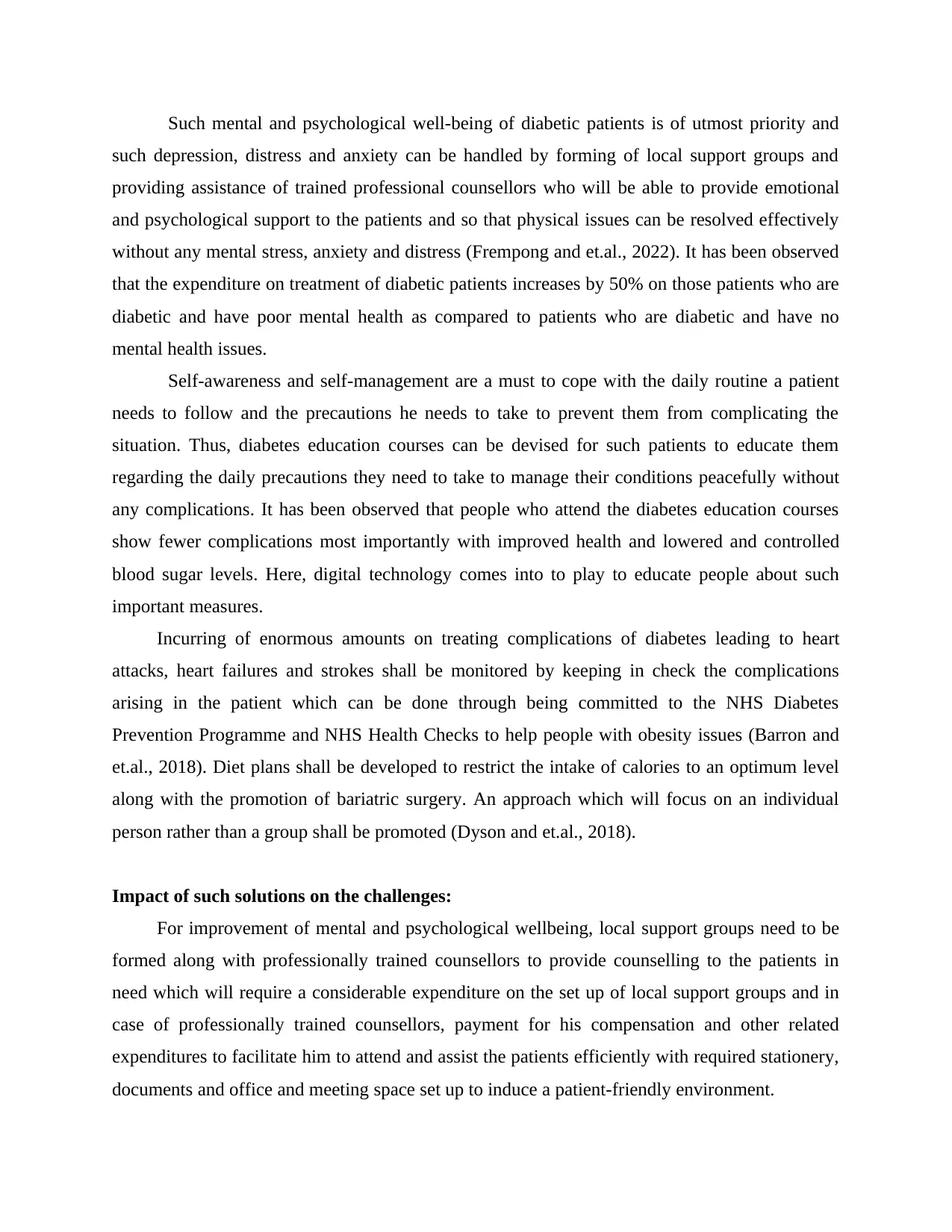
Such mental and psychological well-being of diabetic patients is of utmost priority and
such depression, distress and anxiety can be handled by forming of local support groups and
providing assistance of trained professional counsellors who will be able to provide emotional
and psychological support to the patients and so that physical issues can be resolved effectively
without any mental stress, anxiety and distress (Frempong and et.al., 2022). It has been observed
that the expenditure on treatment of diabetic patients increases by 50% on those patients who are
diabetic and have poor mental health as compared to patients who are diabetic and have no
mental health issues.
Self-awareness and self-management are a must to cope with the daily routine a patient
needs to follow and the precautions he needs to take to prevent them from complicating the
situation. Thus, diabetes education courses can be devised for such patients to educate them
regarding the daily precautions they need to take to manage their conditions peacefully without
any complications. It has been observed that people who attend the diabetes education courses
show fewer complications most importantly with improved health and lowered and controlled
blood sugar levels. Here, digital technology comes into to play to educate people about such
important measures.
Incurring of enormous amounts on treating complications of diabetes leading to heart
attacks, heart failures and strokes shall be monitored by keeping in check the complications
arising in the patient which can be done through being committed to the NHS Diabetes
Prevention Programme and NHS Health Checks to help people with obesity issues (Barron and
et.al., 2018). Diet plans shall be developed to restrict the intake of calories to an optimum level
along with the promotion of bariatric surgery. An approach which will focus on an individual
person rather than a group shall be promoted (Dyson and et.al., 2018).
Impact of such solutions on the challenges:
For improvement of mental and psychological wellbeing, local support groups need to be
formed along with professionally trained counsellors to provide counselling to the patients in
need which will require a considerable expenditure on the set up of local support groups and in
case of professionally trained counsellors, payment for his compensation and other related
expenditures to facilitate him to attend and assist the patients efficiently with required stationery,
documents and office and meeting space set up to induce a patient-friendly environment.
such depression, distress and anxiety can be handled by forming of local support groups and
providing assistance of trained professional counsellors who will be able to provide emotional
and psychological support to the patients and so that physical issues can be resolved effectively
without any mental stress, anxiety and distress (Frempong and et.al., 2022). It has been observed
that the expenditure on treatment of diabetic patients increases by 50% on those patients who are
diabetic and have poor mental health as compared to patients who are diabetic and have no
mental health issues.
Self-awareness and self-management are a must to cope with the daily routine a patient
needs to follow and the precautions he needs to take to prevent them from complicating the
situation. Thus, diabetes education courses can be devised for such patients to educate them
regarding the daily precautions they need to take to manage their conditions peacefully without
any complications. It has been observed that people who attend the diabetes education courses
show fewer complications most importantly with improved health and lowered and controlled
blood sugar levels. Here, digital technology comes into to play to educate people about such
important measures.
Incurring of enormous amounts on treating complications of diabetes leading to heart
attacks, heart failures and strokes shall be monitored by keeping in check the complications
arising in the patient which can be done through being committed to the NHS Diabetes
Prevention Programme and NHS Health Checks to help people with obesity issues (Barron and
et.al., 2018). Diet plans shall be developed to restrict the intake of calories to an optimum level
along with the promotion of bariatric surgery. An approach which will focus on an individual
person rather than a group shall be promoted (Dyson and et.al., 2018).
Impact of such solutions on the challenges:
For improvement of mental and psychological wellbeing, local support groups need to be
formed along with professionally trained counsellors to provide counselling to the patients in
need which will require a considerable expenditure on the set up of local support groups and in
case of professionally trained counsellors, payment for his compensation and other related
expenditures to facilitate him to attend and assist the patients efficiently with required stationery,
documents and office and meeting space set up to induce a patient-friendly environment.
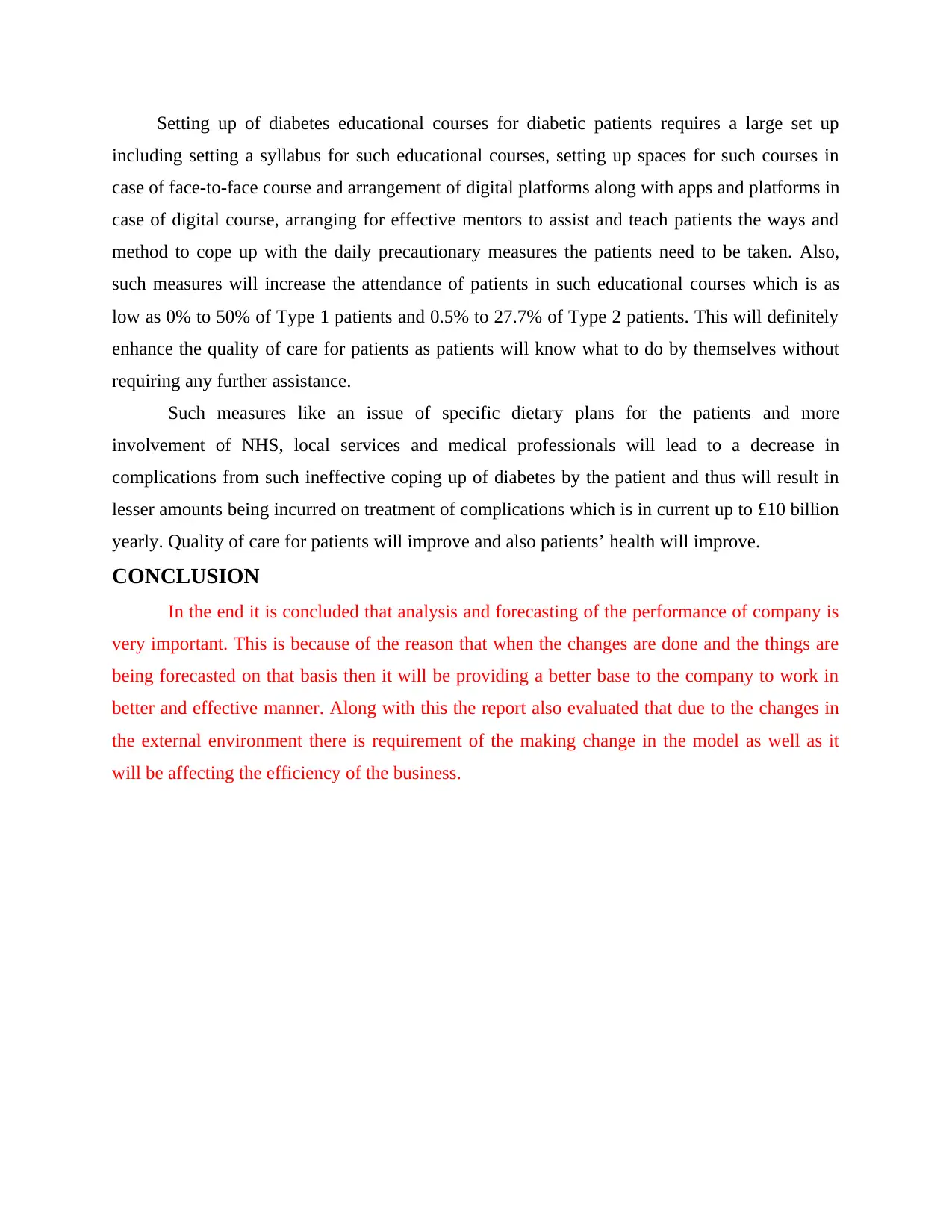
Setting up of diabetes educational courses for diabetic patients requires a large set up
including setting a syllabus for such educational courses, setting up spaces for such courses in
case of face-to-face course and arrangement of digital platforms along with apps and platforms in
case of digital course, arranging for effective mentors to assist and teach patients the ways and
method to cope up with the daily precautionary measures the patients need to be taken. Also,
such measures will increase the attendance of patients in such educational courses which is as
low as 0% to 50% of Type 1 patients and 0.5% to 27.7% of Type 2 patients. This will definitely
enhance the quality of care for patients as patients will know what to do by themselves without
requiring any further assistance.
Such measures like an issue of specific dietary plans for the patients and more
involvement of NHS, local services and medical professionals will lead to a decrease in
complications from such ineffective coping up of diabetes by the patient and thus will result in
lesser amounts being incurred on treatment of complications which is in current up to £10 billion
yearly. Quality of care for patients will improve and also patients’ health will improve.
CONCLUSION
In the end it is concluded that analysis and forecasting of the performance of company is
very important. This is because of the reason that when the changes are done and the things are
being forecasted on that basis then it will be providing a better base to the company to work in
better and effective manner. Along with this the report also evaluated that due to the changes in
the external environment there is requirement of the making change in the model as well as it
will be affecting the efficiency of the business.
including setting a syllabus for such educational courses, setting up spaces for such courses in
case of face-to-face course and arrangement of digital platforms along with apps and platforms in
case of digital course, arranging for effective mentors to assist and teach patients the ways and
method to cope up with the daily precautionary measures the patients need to be taken. Also,
such measures will increase the attendance of patients in such educational courses which is as
low as 0% to 50% of Type 1 patients and 0.5% to 27.7% of Type 2 patients. This will definitely
enhance the quality of care for patients as patients will know what to do by themselves without
requiring any further assistance.
Such measures like an issue of specific dietary plans for the patients and more
involvement of NHS, local services and medical professionals will lead to a decrease in
complications from such ineffective coping up of diabetes by the patient and thus will result in
lesser amounts being incurred on treatment of complications which is in current up to £10 billion
yearly. Quality of care for patients will improve and also patients’ health will improve.
CONCLUSION
In the end it is concluded that analysis and forecasting of the performance of company is
very important. This is because of the reason that when the changes are done and the things are
being forecasted on that basis then it will be providing a better base to the company to work in
better and effective manner. Along with this the report also evaluated that due to the changes in
the external environment there is requirement of the making change in the model as well as it
will be affecting the efficiency of the business.
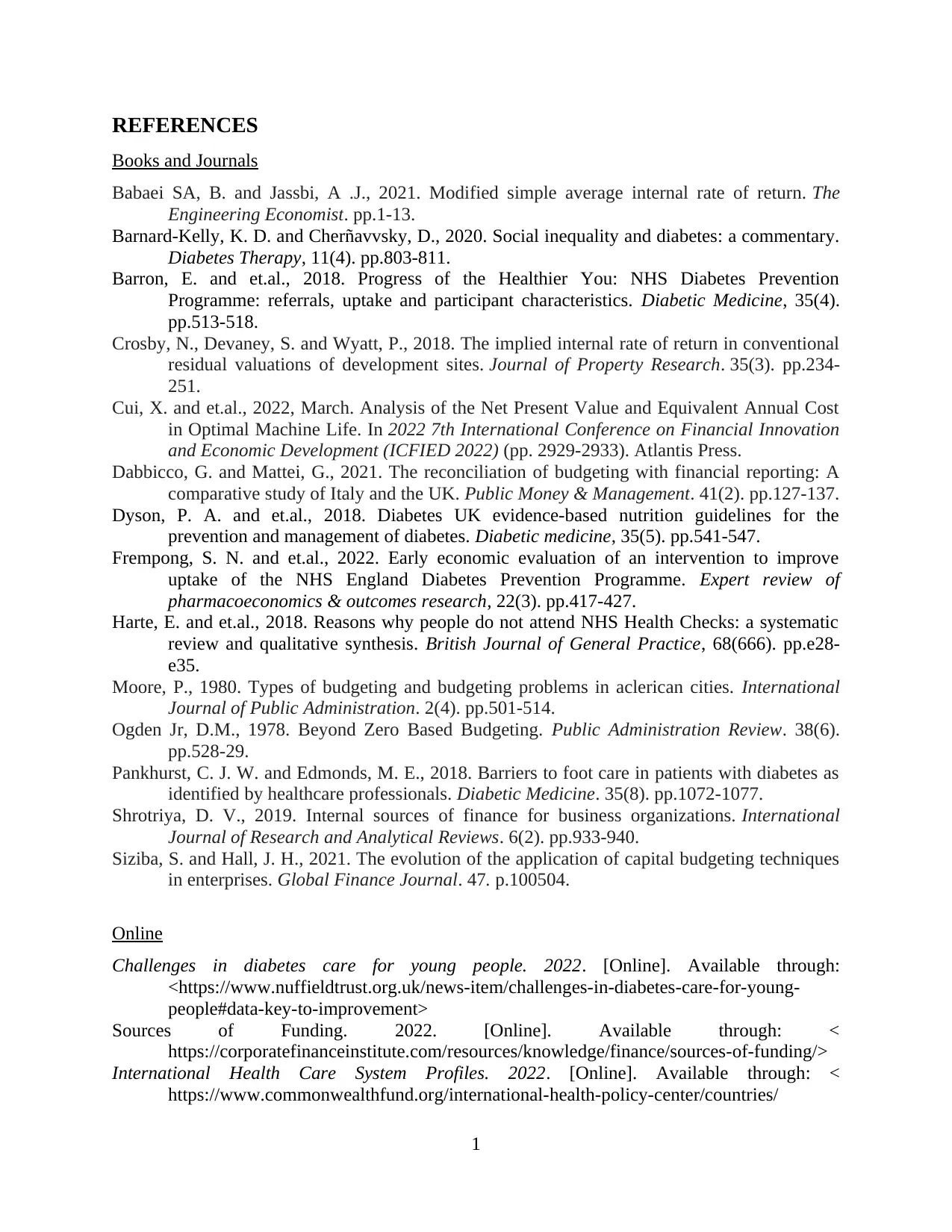
REFERENCES
Books and Journals
Babaei SA, B. and Jassbi, A .J., 2021. Modified simple average internal rate of return. The
Engineering Economist. pp.1-13.
Barnard-Kelly, K. D. and Cherñavvsky, D., 2020. Social inequality and diabetes: a commentary.
Diabetes Therapy, 11(4). pp.803-811.
Barron, E. and et.al., 2018. Progress of the Healthier You: NHS Diabetes Prevention
Programme: referrals, uptake and participant characteristics. Diabetic Medicine, 35(4).
pp.513-518.
Crosby, N., Devaney, S. and Wyatt, P., 2018. The implied internal rate of return in conventional
residual valuations of development sites. Journal of Property Research. 35(3). pp.234-
251.
Cui, X. and et.al., 2022, March. Analysis of the Net Present Value and Equivalent Annual Cost
in Optimal Machine Life. In 2022 7th International Conference on Financial Innovation
and Economic Development (ICFIED 2022) (pp. 2929-2933). Atlantis Press.
Dabbicco, G. and Mattei, G., 2021. The reconciliation of budgeting with financial reporting: A
comparative study of Italy and the UK. Public Money & Management. 41(2). pp.127-137.
Dyson, P. A. and et.al., 2018. Diabetes UK evidence‐based nutrition guidelines for the
prevention and management of diabetes. Diabetic medicine, 35(5). pp.541-547.
Frempong, S. N. and et.al., 2022. Early economic evaluation of an intervention to improve
uptake of the NHS England Diabetes Prevention Programme. Expert review of
pharmacoeconomics & outcomes research, 22(3). pp.417-427.
Harte, E. and et.al., 2018. Reasons why people do not attend NHS Health Checks: a systematic
review and qualitative synthesis. British Journal of General Practice, 68(666). pp.e28-
e35.
Moore, P., 1980. Types of budgeting and budgeting problems in aclerican cities. International
Journal of Public Administration. 2(4). pp.501-514.
Ogden Jr, D.M., 1978. Beyond Zero Based Budgeting. Public Administration Review. 38(6).
pp.528-29.
Pankhurst, C. J. W. and Edmonds, M. E., 2018. Barriers to foot care in patients with diabetes as
identified by healthcare professionals. Diabetic Medicine. 35(8). pp.1072-1077.
Shrotriya, D. V., 2019. Internal sources of finance for business organizations. International
Journal of Research and Analytical Reviews. 6(2). pp.933-940.
Siziba, S. and Hall, J. H., 2021. The evolution of the application of capital budgeting techniques
in enterprises. Global Finance Journal. 47. p.100504.
Online
Challenges in diabetes care for young people. 2022. [Online]. Available through:
<https://www.nuffieldtrust.org.uk/news-item/challenges-in-diabetes-care-for-young-
people#data-key-to-improvement>
Sources of Funding. 2022. [Online]. Available through: <
https://corporatefinanceinstitute.com/resources/knowledge/finance/sources-of-funding/>
International Health Care System Profiles. 2022. [Online]. Available through: <
https://www.commonwealthfund.org/international-health-policy-center/countries/
1
Books and Journals
Babaei SA, B. and Jassbi, A .J., 2021. Modified simple average internal rate of return. The
Engineering Economist. pp.1-13.
Barnard-Kelly, K. D. and Cherñavvsky, D., 2020. Social inequality and diabetes: a commentary.
Diabetes Therapy, 11(4). pp.803-811.
Barron, E. and et.al., 2018. Progress of the Healthier You: NHS Diabetes Prevention
Programme: referrals, uptake and participant characteristics. Diabetic Medicine, 35(4).
pp.513-518.
Crosby, N., Devaney, S. and Wyatt, P., 2018. The implied internal rate of return in conventional
residual valuations of development sites. Journal of Property Research. 35(3). pp.234-
251.
Cui, X. and et.al., 2022, March. Analysis of the Net Present Value and Equivalent Annual Cost
in Optimal Machine Life. In 2022 7th International Conference on Financial Innovation
and Economic Development (ICFIED 2022) (pp. 2929-2933). Atlantis Press.
Dabbicco, G. and Mattei, G., 2021. The reconciliation of budgeting with financial reporting: A
comparative study of Italy and the UK. Public Money & Management. 41(2). pp.127-137.
Dyson, P. A. and et.al., 2018. Diabetes UK evidence‐based nutrition guidelines for the
prevention and management of diabetes. Diabetic medicine, 35(5). pp.541-547.
Frempong, S. N. and et.al., 2022. Early economic evaluation of an intervention to improve
uptake of the NHS England Diabetes Prevention Programme. Expert review of
pharmacoeconomics & outcomes research, 22(3). pp.417-427.
Harte, E. and et.al., 2018. Reasons why people do not attend NHS Health Checks: a systematic
review and qualitative synthesis. British Journal of General Practice, 68(666). pp.e28-
e35.
Moore, P., 1980. Types of budgeting and budgeting problems in aclerican cities. International
Journal of Public Administration. 2(4). pp.501-514.
Ogden Jr, D.M., 1978. Beyond Zero Based Budgeting. Public Administration Review. 38(6).
pp.528-29.
Pankhurst, C. J. W. and Edmonds, M. E., 2018. Barriers to foot care in patients with diabetes as
identified by healthcare professionals. Diabetic Medicine. 35(8). pp.1072-1077.
Shrotriya, D. V., 2019. Internal sources of finance for business organizations. International
Journal of Research and Analytical Reviews. 6(2). pp.933-940.
Siziba, S. and Hall, J. H., 2021. The evolution of the application of capital budgeting techniques
in enterprises. Global Finance Journal. 47. p.100504.
Online
Challenges in diabetes care for young people. 2022. [Online]. Available through:
<https://www.nuffieldtrust.org.uk/news-item/challenges-in-diabetes-care-for-young-
people#data-key-to-improvement>
Sources of Funding. 2022. [Online]. Available through: <
https://corporatefinanceinstitute.com/resources/knowledge/finance/sources-of-funding/>
International Health Care System Profiles. 2022. [Online]. Available through: <
https://www.commonwealthfund.org/international-health-policy-center/countries/
1
Secure Best Marks with AI Grader
Need help grading? Try our AI Grader for instant feedback on your assignments.

england#:~:text=The%20majority%20of%20NHS%20funding,NHS%20services%20as
%20private%20patients.>
2
%20private%20patients.>
2
1 out of 17
Your All-in-One AI-Powered Toolkit for Academic Success.
+13062052269
info@desklib.com
Available 24*7 on WhatsApp / Email
![[object Object]](/_next/static/media/star-bottom.7253800d.svg)
Unlock your academic potential
© 2024 | Zucol Services PVT LTD | All rights reserved.